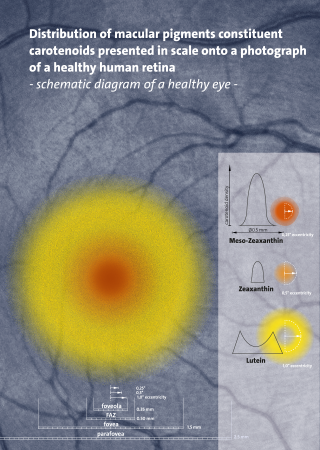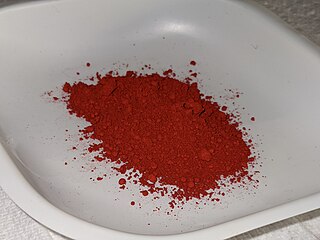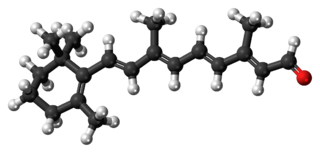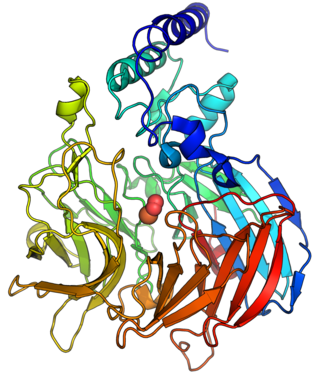
The term carotene (also carotin, from the Latin carota, "carrot") is used for many related unsaturated hydrocarbon substances having the formula C40Hx, which are synthesized by plants but in general cannot be made by animals (with the exception of some aphids and spider mites which acquired the synthesizing genes from fungi). Carotenes are photosynthetic pigments important for photosynthesis. Carotenes contain no oxygen atoms. They absorb ultraviolet, violet, and blue light and scatter orange or red light, and (in low concentrations) yellow light.

Vitamin A is a fat-soluble vitamin and an essential nutrient for animals. The term "vitamin A" encompasses a group of chemically related organic compounds that includes retinol, retinal, retinoic acid, and several provitamin (precursor) carotenoids, most notably beta-carotene. Vitamin A has multiple functions: it is essential for embryo development and growth, for maintenance of the immune system, and for vision, where it combines with the protein opsin to form rhodopsin – the light-absorbing molecule necessary for both low-light and color vision.

Carotenoids are yellow, orange, and red organic pigments that are produced by plants and algae, as well as several bacteria, archaea, and fungi. Carotenoids give the characteristic color to pumpkins, carrots, parsnips, corn, tomatoes, canaries, flamingos, salmon, lobster, shrimp, and daffodils. Over 1,100 identified carotenoids can be further categorized into two classes – xanthophylls and carotenes.

β-Carotene (beta-carotene) is an organic, strongly coloured red-orange pigment abundant in fungi, plants, and fruits. It is a member of the carotenes, which are terpenoids (isoprenoids), synthesized biochemically from eight isoprene units and thus having 40 carbons. Among the carotenes, β-carotene is distinguished by having beta-rings at both ends of the molecule. β-Carotene is biosynthesized from geranylgeranyl pyrophosphate.

Retinal is a polyene chromophore. Retinal, bound to proteins called opsins, is the chemical basis of visual phototransduction, the light-detection stage of visual perception (vision).
The ionones, from greek ἴον ion "violet", are a series of closely related chemical substances that are part of a group of compounds known as rose ketones, which also includes damascones and damascenones. Ionones are aroma compounds found in a variety of essential oils, including rose oil. β-Ionone is a significant contributor to the aroma of roses, despite its relatively low concentration, and is an important fragrance chemical used in perfumery. The ionones are derived from the degradation of carotenoids.
An oxygenase is any enzyme that oxidizes a substrate by transferring the oxygen from molecular oxygen O2 (as in air) to it. The oxygenases form a class of oxidoreductases; their EC number is EC 1.13 or EC 1.14.

Carotenoid oxygenases are a family of enzymes involved in the cleavage of carotenoids to produce, for example, retinol, commonly known as vitamin A. This family includes an enzyme known as RPE65 which is abundantly expressed in the retinal pigment epithelium where it catalyzed the formation of 11-cis-retinol from all-trans-retinyl esters.

In enzymology, beta-carotene 15,15'-dioxygenase, (EC 1.13.11.63) is an enzyme with systematic name beta-carotene:oxygen 15,15'-dioxygenase (bond-cleaving). In human it is encoded by the BCDO2 gene. This enzyme catalyses the following chemical reaction
Apo-beta-carotenoid-14',13'-dioxygenase (EC 1.13.11.67 is an enzyme that catalyzes the chemical reaction

Damascenones are a series of closely related chemical compounds that are components of a variety of essential oils. The damascenones belong to a family of chemicals known as rose ketones, which also includes damascones and ionones. beta-Damascenone is a major contributor to the aroma of roses, despite its very low concentration, and is an important fragrance chemical used in perfumery.

9-cis-epoxycarotenoid dioxygenase (EC 1.13.11.51, nine-cis-epoxycarotenoid dioxygenase, NCED, AtNCED3, PvNCED1, VP14) is an enzyme in the biosynthesis of abscisic acid (ABA), with systematic name 9-cis-epoxycarotenoid 11,12-dioxygenase. This enzyme catalyses the following chemical reaction
8'-apo-beta-carotenoid 14',13'-cleaving dioxygenase (EC 1.13.11.67) is an enzyme with systematic name 8'-apo-beta-carotenol:O2 oxidoreductase (14',13'-cleaving). This enzyme catalyses the following chemical reaction
9-cis-beta-carotene 9',10'-cleaving dioxygenase (EC 1.13.11.68, CCD7 (gene), MAX3 (gene), NCED7 (gene)) is an enzyme with systematic name 9-cis-beta-carotene:O2 oxidoreductase (9',10'-cleaving). This enzyme catalyses the following chemical reaction
Carlactone synthase (EC 1.13.11.69, CCD8 (gene), MAX4 (gene), NCED8 (gene)) is an enzyme with systematic name 9-cis-10'-apo-beta-carotenal:O2 oxidoreductase (14,15-cleaving, carlactone-forming). This enzyme catalyses the following chemical reaction
All-trans-10'-apo-beta-carotenal 13,14-cleaving dioxygenase (EC 1.13.11.70, CCD8 (gene), MAX4 (gene), NCED8 (gene)) is an enzyme with systematic name all-trans-10'-apo-beta-carotenal:O2 oxidoreductase (13,14-cleaving). This enzyme catalyses the following chemical reaction
Beta-carotene 3-hydroxylase (EC 1.14.13.129, beta-carotene 3,3'-monooxygenase, CrtZ) is an enzyme with systematic name beta-carotene,NADH:oxygen 3-oxidoreductase . This enzyme catalyses the following chemical reaction
All-trans-8'-apo-beta-carotenal 15,15'-oxygenase (EC 1.14.99.41, Diox1, ACO, 8'-apo-beta-carotenal 15,15'-oxygenase) is an enzyme with systematic name all-trans-8'-apo-beta-carotenal:oxygen 15,15'-oxidoreductase (bond-cleaving). This enzyme catalyses the following chemical reaction
Carotene epsilon-monooxygenase (EC 1.14.99.45, CYP97C1, LUT1) is an enzyme with systematic name alpha-carotene:oxygen oxidoreductase (3-hydroxylating). This enzyme catalyses the following chemical reaction
Prolycopene isomerase is an enzyme with systematic name 7,9,7',9'-tetracis-lycopene cis-trans-isomerase. This enzyme catalyses the following chemical reaction









